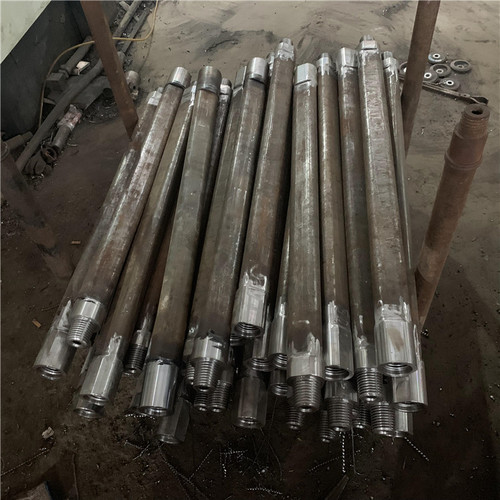Everyone knows geological drill pipe is the backbone of a drilling rig
Geological drill pipe is a super important, core tool in geological exploration and engineering. Think of it like the "skeleton" of the Drilling Rig. It's tasked with crucial jobs: transferring power underground, delivering drilling fluid, and bringing rock core or cuttings back to the surface. Understanding how geological drill pipe works really helps us do a better job with drilling.

What Does Geological Drill Pipe Basically Do?
1. Power Transmission: It takes the rotational torque and downward pressure from the surface drilling rig and delivers it to the drill bit at the bottom of the hole, making the bit break rock.
2. Medium Delivery: It acts as a channel to send flushing fluid down to the drill bit. This fluid cools the bit, lubricates the drilling tools, and cleans out drill cuttings from the bottom of the hole.
3. Sample Retrieval: In core drilling, the drill pipe has space inside for a coring tool. This tool collects intact rock core samples from the formation and brings them back to the surface. In some drilling methods, the inside of the drill pipe is also where cuttings return.
4. Deepening the Hole: By continuously connecting new drill pipes, you can gradually lengthen the drill string, allowing the drill bit to keep going deeper underground and extend the wellbore.
How Geological Drill Pipe Works – It's a Team Effort!
1. Connecting and Extending:
Geological drill pipes usually have a pipe body and joints at both ends.
When drilling starts, you connect the first drill pipe to the rig's power head and attach the drill bit.
As the drill bit goes down and the hole gets deeper, once one drill pipe has drilled its full length, the rig stops. Then, a new drill pipe is connected to the top of the drill string already in the hole, extending the string. This process is called making a connection.
2. Transmitting Rotation and Downward Pressure:
The surface drilling rig generates rotational power and downward pressure.
This rotational power travels down the drill pipe string, section by section, all the way to the drill bit at the bottom of the hole. The drill pipe's high strength and torsional resistance ensure this power transfer is efficient and reliable.
At the same time, the weight on bit applied by the rig's hoisting or hydraulic system also travels down the drill pipe string, allowing the drill bit to effectively break rock.
3. Circulating Flushing Medium:
Drill pipe is a hollow, tubular structure. A Mud Pump on the surface injects the flushing medium into the top of the drill pipe through a high-pressure hose.
The flushing medium flows down the inside channel of the drill pipe, all the way to the drill bit at the bottom of the hole.
The drill bit has nozzles or watercourses designed into it. The flushing medium sprays out of these openings at high speed, not only cooling and lubricating the drill bit, but, more importantly, carrying the rock cuttings broken by the drill bit away from the bottom of the hole.
The flushing medium, now carrying the cuttings, then travels upward through the annular space between the drill pipe and the wellbore, eventually reaching the surface and going into the mud pit for processing. This circulating process is called direct circulation.
4. Sample Retrieval and Drilling Methods:
Conventional Rotary Drilling: Drill pipe mainly transmits power and flushes the hole. Cuttings return with the flushing fluid.
Wireline Coring Drilling: This drill pipe has a larger inner diameter, which allows a special core barrel to be lowered by wireline to the drill bit to collect rock core while drilling. After coring, the core barrel is pulled out with the wireline, without needing to trip the entire drill string out, greatly improving coring efficiency.
DTH Drilling: Drill pipe primarily transmits compressed air or hydraulic fluid to power the DTH hammer at the bottom of the hole. The DTH hammer breaks rock through high-speed impact on the drill bit, and cuttings return either through the inside of the drill pipe or the annulus.
Reverse Circulation Drilling: Opposite to direct circulation, the flushing medium enters the bottom of the hole from the annulus and returns to the surface with the cuttings through the internal channel of the drill pipe. This method is advantageous for loose formations and large-diameter holes.

Key Characteristics of Geological Drill Pipe
1. High Strength and Toughness: It must be able to withstand huge tensile, compressive, torsional, and bending stresses, as well as impacts and vibrations during drilling.
2. Wear Resistance: The pipe body and joint surfaces need to have good wear resistance to handle friction with the wellbore, cuttings, and drilling fluid.
3. Good Sealing: The joint threads must be precisely machined to ensure the flushing fluid doesn't leak while circulating inside the drill pipe, especially under high pressure.
4. Standard Dimensions and Connections: This ensures that different lengths of drill pipe can connect precisely and match perfectly with other drill string components like the drill bit and the rig's power head.

Click here to talk to us if you want to know more:
Geological drill pipe
We're here to help you get the best drilling stuff and service.


